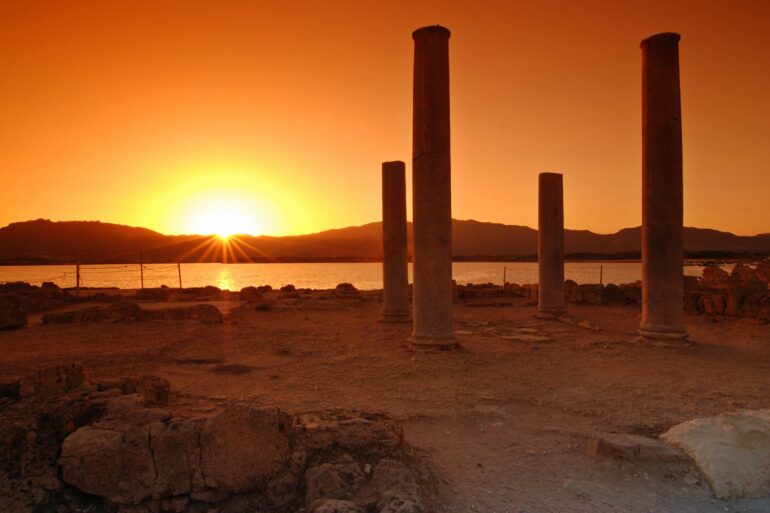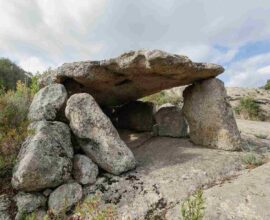Monuments of ancient Sardinia: 5 unmissable places from North to South in the island
A journey across the most evocative places from ancient Sardinia
From the Nora Archaeological Park in Pula to the Temple of Antas in Fluminimaggiore, crossing also Coddu Vecchiu’s Tomb of Giants in Arzachena, here are five monuments in Sardinia where time feels like have stopped by in a distant age.
In Sardinia, the past is never just a memory. It’s a watchful witness, silently intertwined with the present and tracing the path towards the future, always keeping the ancient soul of the island alive and shining. It’s a process of transformation, rather evolution, running on two parallel tracks: every stone, every ruin, every monument is a clear trace of history and also an invitation to discovery and reflection. Here, time doesn’t flow linearly as elsewhere, but is stratified, adding new depth and meaning each time.
The monuments of ancient Sardinia, with their timeless beauty and simply magnetic charm, thus tell stories about legendary peoples who lived in harmony with the land, mysterious rites halfway between sacred and profane, and ancestral knowledge passed down across generations.
Crossing these places, harmoniously present on over 24.100 km2 of the island’s territory, therefore allows to take a real journey into its most authentic heart. A journey that’s not only physical, but even historical, spiritual and emotional.
From the imposing nuraghi, which stand as silent guardians of a never forgotten past, to the mysterious tombs of giants, evidence of a lost way to conceive death and afterlife, each monument in Sardinia is a piece of a wide puzzle inviting to reflect on these people’s origins and identities, the Sardinian people, still strongly bound to its traditions and its past.
From North to South, here’s a journey in five stages across magical monuments to celebrate the extraordinary legacy of ancient Sardinia.
Monuments of ancient Sardinia: a five-stops journey through the most evocative places
A trip to Sardinia is never a simple one: it’s an adventure enabling to access, stage after stage, a new level of understanding of the intricate, multifaceted, and extremely fascinating maze of cultures, dialects and peoples that here coexisted and integrated each other in a harmonious, yet surprising way, shaping the rich heritage of shared symbols and stories that today we commonly associate with the idea of Sardinianness.
Following, five places where to stop – for a few minutes, hours, or even days – to savor the most authentic “flavor” of the Island, and spend quality time in the company of your loved ones on the backdrop of simply breathtaking natural landscapes.
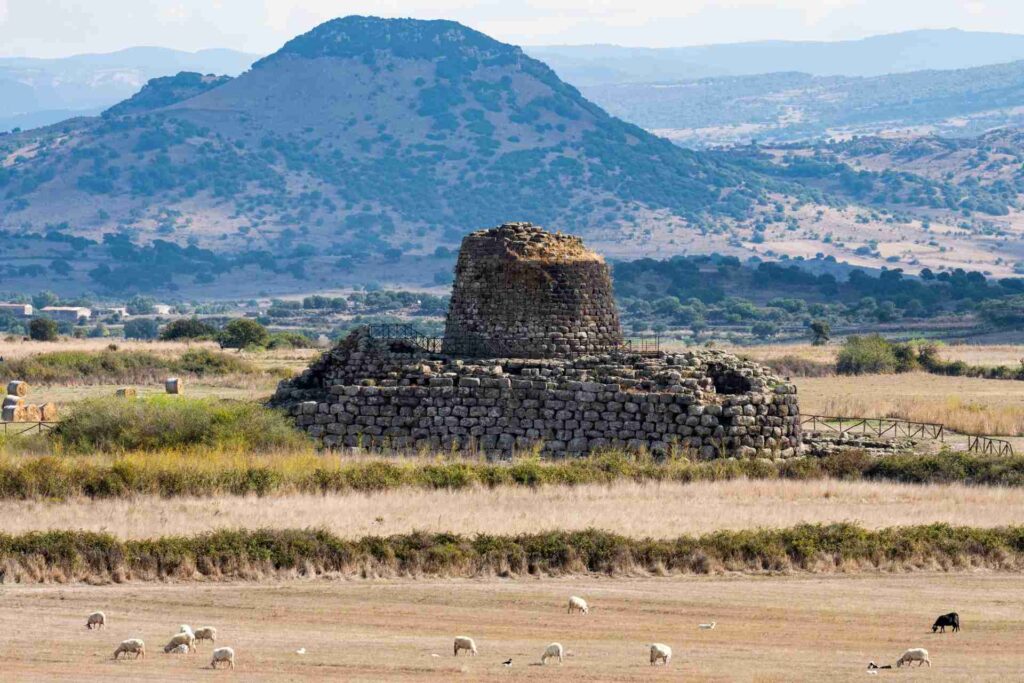
1. Nuraghe Santu Antine (Torralba, Sassari)
The journey through the monuments of ancient Sardinia begins with the majestic Nuraghe Santu Antine, an imposing construction that stands out over Valle dei Nuraghi, near the picturesque village of Torralba (Turalva in Sardinian), in the heart of Meilogu, a sub-region of Logudoro.
We’re in the north-western side of Sardinia, a territory populated by spectacular inactive volcanic craters, yet by the evidence of ancient Nuragic civilizations that thrived here in a time span approximately between 1800 BC and the 3rd century BC, embracing both Bronze and Iron Age and the Historical Era.
In a relatively limited area, nestled between green hills and enchanted valleys, there are more than ten tombs of giants and over thirty nuraghi, including Santu Antine, which together with Barumini in the Su Nuraxi nuragic village, located in the heart of the historical sub-region of Marmilla, part of the province of Sud Sardegna, is among the most visited and best preserved on the whole island.
Dating back to the 2nd millennium BC, this monument made with massive limestone blocks immediately catches eye’s attention with its large cylindrical tower that challenges space and time, reaching a height of about 18 meters and showing the notable architectural skills of ancient local builders.
Entering the nuraghe, you come across a central hall characterized by a vaulted ceiling and three niches, whose functions are still mysterious nowadays: they could have been used for rituals or to store precious things; anyway, imagining them full of life, sounds and stories, takes us back right away to a distant era, an invitation to immerse in the daily life of an ancient and complex society, partly still shrouded in mystery.

2. Coddu Vecchiu’s Tomb of Giants (Arzachena, Sassari)
Continuing towards Costa Smeralda, the enchanting stretch of coast of Arzachena (province of Sassari) extending from Capo Ferro to the Gulf of Cugnana, we come across another incredible testimony of ancient Sardinia: Coddu Vecchiu’s Tomb of Giants, also known as Coddu Vecchju or ‘Ecchju.
It is an ancient tomb built in several phases starting from the Early Bronze Age (18th century BC) using local materials such as granite, and completed in the following centuries, during the so-called Middle Bronze Age (between 16th and 14th centuries BC), with the addition of the frontal exedra to the original gallery tomb, where were found many fragments of vases used for the preparation and consumption of food and drink, probably used on funeral rites and ceremonies in honor of ancestors, and the imposing arched stele.
A slab that, with its over four meters, holds a record for the highest in Sardinia, an important testimony to the top level of sophistication of architectural techniques, which symbolically served as a gateway to the Kingdom of the Dead. It’s also interesting to observe how inside the funerary corridor the bodies were buried without distinction of sex, age or social role, proving the equality that characterized the Nuragic community about death.
The monument is located just 700 meters from La Prisgiona nuragic complex and immersed in lush vegetation that helps create a sense of intimacy that truly makes the visit an even more intense and contemplative experience, a moment for questioning mankind’s very roots.

3. Santa Cristina’s Sacred Well (Paulilatino, Oristano)
Moving inland, to the municipality of Paulilatino, a picturesque village counting about two thousand inhabitants surrounded by lush cork groves, olive groves and vineyards, located in the southernmost portion of the vast basaltic plateau of Abbasanta, between Campidano and Montiferro, we then find the Santa Cristina’s Sacred Well. The most representative and best preserved Nuragic well temple in Sardinia, whose name derives from the proximity to the namesake chapel dedicated to the virgin martyr of Bolsena, today considered one of the greatest architectural expressions of the Nuragic civilization on the island territory.
It’s also a place rich in spirituality and mysticism, where peace and silence reign, primarily arising from the amazing order and geometric perfection in the arrangement of the squared stones surrounding the entrance of the building, characterized by a clover-shaped plan including three main elements: the vestibule, the descending staircase and the hypogeal chamber in which the water reserve is located.
The vestibule, a rectangular passage built with stones cut with extreme precision, serves as an introduction to the sacred area and accompanies visitors to the central element: the staircase, which with its 25 perfectly symmetrical steps and its vault formed by basalt blocks arranged progressively, leads from the surface towards the hypogeal tholos chamber. In this underground circular cavity, waters are artificially maintained at a constant level of 50 cm through a drainage channel built at the moment of the monument’s discovery in mid-19th century, to allow visits up to the internal portion of the well.
In addition to its function of collecting rainwater, it’s interesting to note the role that this monument played in the cult of ancient gods, such as Mamusa, Sardinian Goddess of Water. A cult that once was particularly heartfelt and widespread, to the point that it is possible to speak of a real “religion of water”, a natural element closely connected to life and creation.
The well’s structure itself has a precise alignment with respect to equinoxes and solstices, an indication of the desire to build a link between the earthly world and the cosmic and divine one: during these moments of the year, the sunlight penetrated through the upper opening and illuminated the chamber in a perfect play of light, showing a clear interest of the ancient populations in astronomy and cosmological symbolism. Additionally, every 18.6 years, during the period of the greatest lunar month, even moonlight penetrates through the hole in the chamber, reflecting perpendicularly into the body of water below.
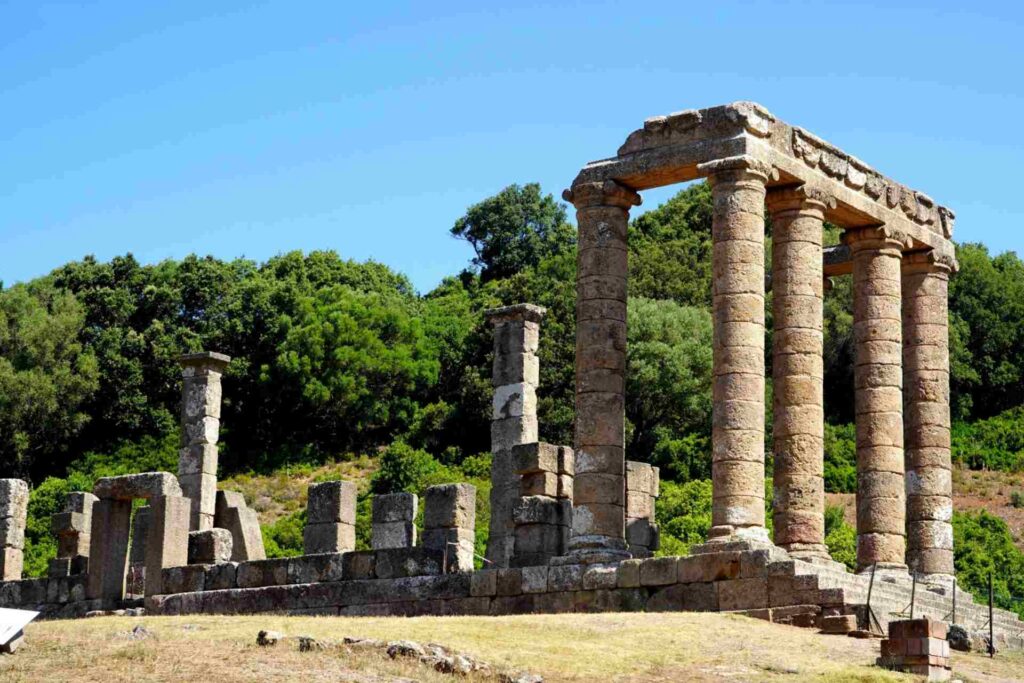
4. Temple of Antas (Fluminimaggiore, Sud Sardegna)
It’s now time to head towards southwestern Sardinia, more precisely to Fluminimaggiore, a small town located in the heart of the Rio Mannu valley (Iglesiente), a true heaven on earth protected by the picturesque Mount Conca s’Omu and shrouded in an almost unreal silence, where it is still possible to see the ruins of an ancient temple of Roman origin, formerly a Nuragic sanctuary also in vogue in the Punic era, the one of Antas.
It is a monument full of history and symbolism, discovered by General La Marmora in 1836 and then restored in the second half of the Sixties, which bears the imprint of the different civilizations that have inhabited the island. The building was in fact built with local limestone in several stages, starting from the 6th century BC. on a sacred site in the Nuragic age, and was first witness to the arrival of the Carthaginians in this particularly fertile area, around which there were abundant deposits of lead and iron, and then towards the middle of the 3rd century BC, of the Romans.
It was specifically in this age that the temple (first dedicated to Punic God, warrior and hunter, Sid Addir and then to the Sardinian equivalent Sardus Pater Babai, an iconic example of the religious syncretism very common during the Roman era) was rebuilt by order of the emperor Augustus, and subsequently renovated by order of Caracalla in the 1st century AD, until it took on the particular configuration that can still be admired today. The temple is in fact distinguishable by the pronaos with four frontal columns and two side ones about eight meters high, characterized by Ionic capitals and smooth shafts, and by the cell accessible from the sides, which extends for eleven meters and houses an adyton (internal cult area) with cisterns for purification rites. On the main pediment there’s still an epigraph dedicated to Caracalla, while the triangular pediment that surmounted it has been lost over time.
The layers of history present on the site make the Temple of Antas a rare example of cultural overlapping, with cults evolving and adapting to new divinities without ever completely erasing the past. Among other things, it is one of the few examples of open-air temples in Sardinia, where the relationship between architectural structure and natural environment creates a unicum with great evocative power.
Indeed, even today while visiting Antas is possible to perceive the ancient charm of a cult that paid homage to divinity, yet to the beauty of nature, revealing how ancient Sardinian cultures knew how to perfectly blend architecture, religion and landscape.
Next to the temple, a necropolis with well tombs dating back to the beginning of the Iron Age preserves votive bronzes, such as a male figure armed with a spear that could represent Sid Addir himself or the Sardus Pater. Moreover, the site includes traces of a Nuragic village, with circular structures inhabited again in the Roman era. Not too far away there’s also a quarry, dating back to Romans, probably used to extract the stones of which the temple is made of, and the nearby Su Mannau Cave, a natural and archaeological wonder, used for pre-Nuragic and Nuragic ceremonies, with a karst complex of extraordinary natural beauty.
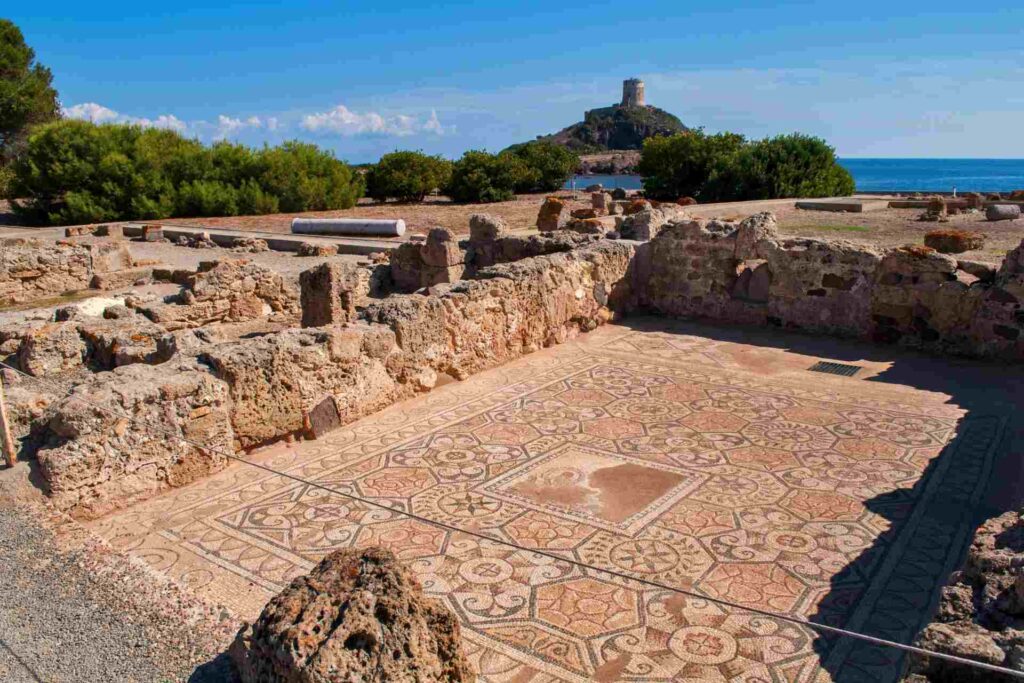
5. Nora Archaeological Area (Pula, Cagliari)
And finally, the tour of the monuments of ancient Sardinia ends at the Nora Archaeological Area, near Pula, just a few kilometers southwest of Cagliari, the first Phoenician settlement on the entire island, founded around the 9th century BC, as well as one of the main hubs of the economy of the time, thanks to its strategic position making it one of the richest ports in the western Mediterranean.
In the 6th century BC, the town came under the dominion of Carthaginians, transforming it into a fortified and populated place, expanding its borders and strengthening its commercial and cultural influence. From this period, only a few defensive structures remain, the tophet, a Phoenician-Punic sanctuary, the remains of the temple dedicated to the goddess Tanit and some artisan plants in the area closest to the seaside demonstrating the use of the city as a hub of exchange and contact with the Punic world.
Among the ancient remains there are also a necropolis with tombs dating back to the end of the 7th century BC and the beginning of the 6th century BC, while the Nora stele, made of sandstone, dates back to the Nuragic-Phoenician time, where the name Sardinia appears for the first time by the word Shrdn, a find of incredible value today preserved within the National Archaeological Museum of Cagliari.
The maximum expansion of Nora was reached with the Roman domination, which began in the 3rd century BC, when the town became an authentic urban centre with important public buildings. Among the most impressive Roman monuments still visible today, the forum, the amphitheater and the theater stand out, actually one of a kind in Sardinia, with a capacity of about one thousand spectators, nowadays still in excellent condition, and the sumptuous noble villas, enriched with precious mosaics, proving the high level of refinement and wealth achieved in this fortunate era.
The archaeological area also preserves the remains of temples and thermal baths, evidence of the great attention that Roman nobles paid to well-being for body and mind, while the stone-paved streets cross the entire site, connecting Nora to the main areas of the city and proving again the great urban organization of this ancient “metropolis”.
The city was rediscovered at the end of the 19th century by Giovanni Spano, Filippo Vivanet and Filippo Nissardi, and today it’s known as one of the most evocative and best preserved archaeological sites in Sardinia, an extremely fascinating journey through different eras, and also as the place where the martyrdom of Sant’Efisio took place, a saint who set Sardinia free from the deadly plague epidemic of the mid-17th century, to whom a small church is dedicated, a destination for pilgrimages in the celebrations of the namesake festival.
Sardinia: ancient monuments, but also relax, sports and great food
Located less than 15 minutes by car from the town of Pula, and less than 45minutes from the Sardinian capital, Forte Village Resort in Santa Margherita di Pula, a five-star facility known for its great attention to couples and families needs, with its excellent sports academies, including much-loved ones dedicated to teaching and improving tennis, padel and swimming, and the creative and manual workshops designed for children, such as the Barbie Academy and the educational garden, is the best place to stay and go discovering many wonderful monuments of ancient Sardinia.
A key factor is the privileged position of the hotels and the resort’s facilities, immersed in over 50 hectares of lush gardens characterized by incredible natural biodiversity, near some of the most beautiful beaches of the island, and the chance of attending unforgettable music shows hosted on the stage of the magnificent Forte Arena, a real amphitheater under the stars of the sky in Southern Sardinia.
Last but not least, the regenerating and relaxing thalassotherapy treatments by Acquaforte Thalasso & Spa, a true temple to take care of the well-being of your body and mind, and a wide range of starred restaurants, including Belvedere by Giuseppe Molaro, Terrazza San Domenico by Massimiliano Mascia and Beachcomber by Heinz Beck.
For further information please phone call to +390709218818 or write an email to holiday@fortevillage.com.
Do you want to discover the monuments of ancient Sardinia and experience a dream holiday in a true paradise? Discover Forte Village Resort in Sardinia
